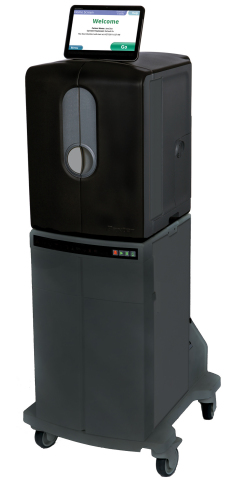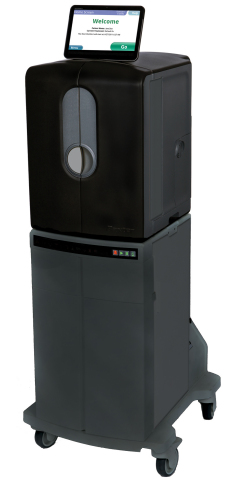DEERFIELD, Ill.--(BUSINESS WIRE)--Baxter International Inc. (NYSE:BAX) today announced completion of CE marking in Europe for the VIVIA hemodialysis (HD) system, designed to deliver more frequent, extended duration, short daily or nocturnal home HD therapy, known as High Dose HD therapy1.
''Globally, less than 1 percent of the estimated 1.9 million patients requiring hemodialysis currently perform High Dose HD therapy,'' said Bruce Culleton, M.D., senior medical director, Baxter. ''VIVIA will allow a greater number of hemodialysis patients access to High Dose HD therapy in their home environment.''
VIVIA is designed with the patient as the primary operator. Its touch screen and graphic user interface displays large, easy-to-comprehend graphics and animations that help guide patients through setup, treatment and cleanup2. VIVIA’s Access Disconnect Sensor causes the system to stop pumping if the needle dislodges1,2. The system also has one-button fluid infusion to help minimize user error and promote additional safety for the patient1. To support the important interface between patients and their healthcare practitioners, VIVIA includes the fully integrated Sharesource wireless connectivity platform that allows physicians and nurses to comprehensively monitor home therapy remotely1.
Baxter will introduce VIVIA in a limited number of European dialysis clinics in 2014 to allow patients and healthcare providers to become familiar with the system and its patient-friendly features. Baxter plans to expand the launch to other European countries in 2015.
Data from clinical trials conducted in the United States and Canada evaluating the safety and effectiveness of VIVIA in more than 1,000 treatments were submitted as part of the filing for CE marking1,3. CE mark is a regulatory requirement for medical devices to be sold in the European Union.
''At Baxter, we are committed to providing physicians and their patients with product and therapy options for the best clinical outcomes possible,'' said Brik Eyre, president of Baxter’s Renal business. ''The VIVIA system was developed to support renal patients’ unmet need for an innovative home-based hemodialysis option.''
Rx only. For safe and proper use of this device, refer to the complete instructions in the operator's manual.
High Dose HD
An estimated 1.9 million end-stage kidney disease (ESKD) patients worldwide undergo hemodialysis, with the vast majority receiving conventional hemodialysis (CHD), which is usually performed three times a week for three to five hours per session in a center or clinic4.
High Dose HD therapy is a more frequent therapy usually performed as short daily treatments at least five days per week for sessions that typically run less than four hours, or as nocturnal treatments where sessions are conducted for greater than six hours while the patient sleeps5. High Dose HD therapy is associated with improvements in survival and clinically important health measures, including health-related quality of life, compared with CHD6,7,8,9.
About Baxter International Inc.
Baxter International Inc., through its subsidiaries, develops, manufactures and markets products that save and sustain the lives of people with hemophilia, immune disorders, infectious diseases, kidney disease, trauma and other chronic and acute medical conditions. As a global, diversified healthcare company, Baxter applies a unique combination of expertise in medical devices, pharmaceuticals and biotechnology to create products that advance patient care worldwide.
This release includes forward-looking statements concerning VIVIA, Baxter’s home hemodialysis system, including expectations regarding the planned launch of VIVIA in Europe and its potential impact on patients. The statements are based on assumptions about many important factors, including the following, which could cause actual results to differ materially from those in the forward-looking statements: actions of regulatory bodies and other governmental authorities; satisfaction of regulatory and other requirements; product quality or patient safety issues; changes in laws and regulations; and other risks identified in Baxter’s most recent filing on Form 10-K and other SEC filings, all of which are available on Baxter’s website. Baxter does not undertake to update its forward-looking statements.
1 Data on file, Baxter International Inc., Oct. 1, 2013
2 Data on file, Baxter International Inc., June 27, 2012
3 Data on file, Baxter International Inc., May 16, 2013
4 Fresenius Medical Care: ESRD Patients in 2011, A Global Perspective. Available at http://www.vision-fmc.com/files/download/ESRD/ESRD_Patients_in_2011.pdf. Accessed September 4, 2013.
5 Data on file, Baxter International Inc., November 8, 2013
6 Pauly RP, Gill JS, Rose CL, et al. Survival among nocturnal home haemodialysis patients compared to kidney transplant recipients. Nephrol Dial Transplant. 2009;24(9):2915-2919.
7 Chertow GM, Levin NW, Beck GJ; FHN Trial Group. In-center hemodialysis six times per week versus three times per week. N Engl J Med. 2010;363(24):2287-2300.
8 Nesrallah GE, Lindsay RM, Cuerden MS, et al. Intensive hemodialysis associates with improved survival compared with conventional hemodialysis. J AM Soc Neprol. In press.
9 Culleton B, et al. Effect of frequent nocturnal hemodialysis vs conventional hemodialysis on left ventricular mass and quality of life. JAMA 2007; 298 (11) 1291-1299.




